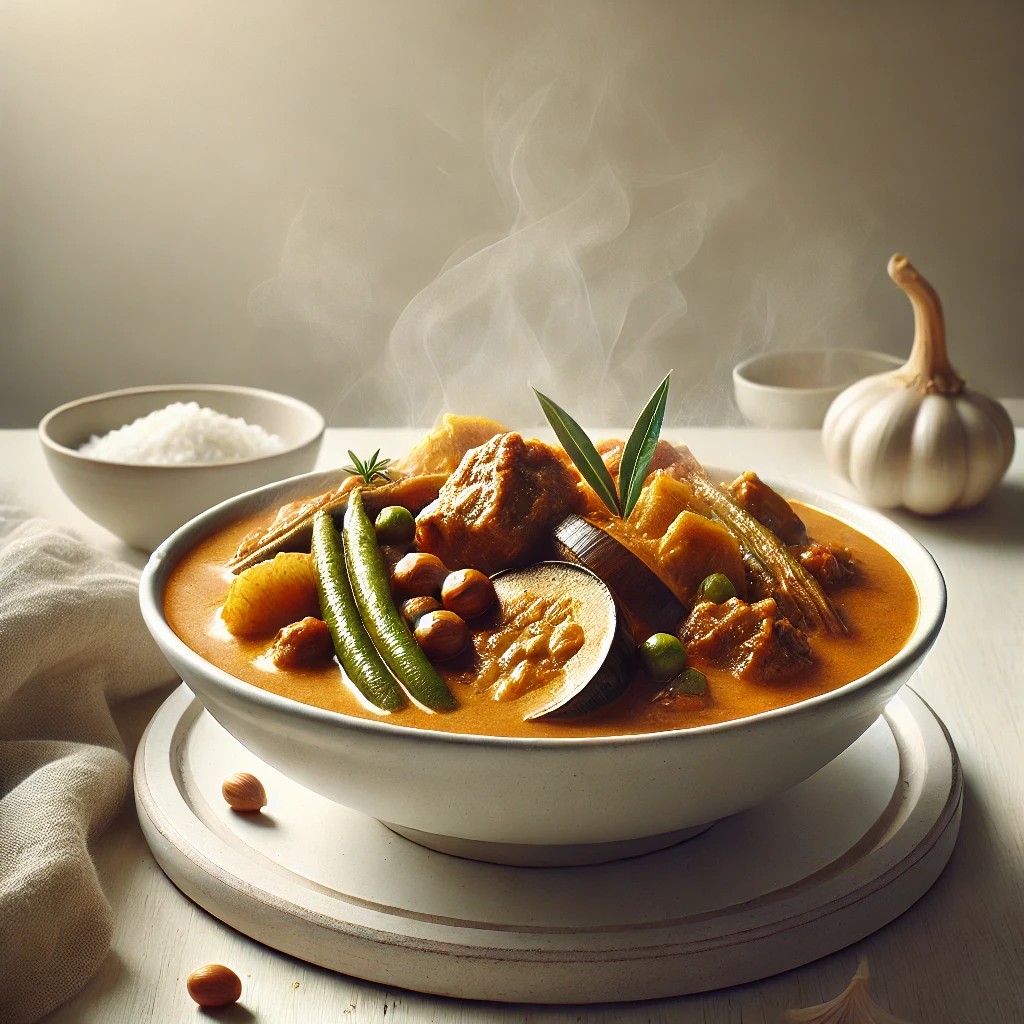Have you ever experienced a dish that makes your taste buds dance with excitement? A dish so tantalizing that it transforms a simple meal into an unforgettable culinary adventure? Allow me to introduce you to Sisig, a sizzling Filipino appetizer that’s guaranteed to captivate your senses and leave you craving more. This iconic dish, with its perfect balance of crispy, savory, and tangy flavors, has been delighting food enthusiasts for decades and has even gained international recognition as one of the world’s best street foods.
Sisig isn’t just a dish; it’s a celebration of Filipino culinary ingenuity. Born from humble beginnings in the culinary capital of Pampanga, this appetizer has evolved from a simple way to use leftover pig parts into a beloved national treasure. What makes Sisig truly special is its ability to bring people together. Served on a sizzling hot plate, it’s meant to be shared, encouraging conversation and camaraderie as diners dig in with gusto.
While traditionally made with pork, Sisig has adapted to modern dietary preferences. Today, you can find variations that cater to different tastes and restrictions, including chicken, tofu, and even bangus (milkfish) versions. This versatility ensures that everyone can enjoy the unique flavors and textures that make Sisig so irresistible. So, whether you’re a meat lover, a vegetarian, or somewhere in between, there’s a Sisig recipe waiting to tantalize your taste buds.
Recipe Ingredients
Let’s dive into the heart of this mouthwatering dish. Here’s what you’ll need to create your very own Sisig masterpiece:
| Ingredient | Quantity |
|---|---|
| Pork belly | 500g |
| Pig ears | 250g |
| Pig liver | 250g |
| Onions | 2 medium, finely chopped |
| Garlic | 6 cloves, minced |
| Red chili peppers | 2-3, finely chopped |
| Calamansi or lime juice | 1/4 cup |
| Soy sauce | 2 tablespoons |
| Vinegar | 2 tablespoons |
| Salt | To taste |
| Black pepper | To taste |
| Cooking oil | 2 tablespoons |
| Egg (optional) | 1 large |
| Green onions | 1/4 cup, chopped |
Substitution suggestions:
- For a leaner option, replace pork belly with pork shoulder.
- If pig ears are unavailable, double the amount of pork belly.
- Vegetarians can use firm tofu and mushrooms instead of pork.
- Calamansi can be substituted with a mix of lemon and lime juice.
Recipe Instructions
Now that we have our ingredients ready, let’s walk through the process of creating this sizzling delicacy. Follow these steps carefully, and you’ll be rewarded with a Sisig that rivals those found in the best Filipino eateries.
- Prepare the meat:
- Boil the pork belly, pig ears, and liver in separate pots until tender (about 30-40 minutes for pork belly and ears, 15-20 minutes for liver).
- Once cooked, drain and let cool.
- Chop the meats into small, uniform pieces (about 1/4 inch cubes).
- Grill the meat:
- Preheat your grill or broiler.
- Grill the chopped pork belly and pig ears until crispy and slightly charred.
- Set aside.
- Sauté the aromatics:
- In a large skillet or wok, heat the cooking oil over medium heat.
- Sauté the minced garlic until fragrant.
- Add the chopped onions and cook until translucent.
- Combine and season:
- Add the grilled pork belly, pig ears, and chopped liver to the skillet.
- Stir in the soy sauce, vinegar, and calamansi juice.
- Season with salt and pepper to taste.
- Cook for 5-7 minutes, stirring occasionally, until the flavors meld together.
- Add the finishing touches:
- Toss in the chopped chili peppers and half of the green onions.
- If using, create a well in the center of the skillet and crack the egg into it.
- Mix the egg into the meat as it cooks.
- Serve:
- Transfer the Sisig to a sizzling hot plate.
- Garnish with the remaining green onions.
- Serve immediately with additional calamansi or lime wedges on the side.
Recipe Tips & Variations
To ensure your Sisig reaches its full potential, consider these helpful tips:
- Texture is key: The contrast between crispy and tender meat is what makes Sisig special. Don’t overcook the liver, as it can become tough and bitter.
- Adjust the heat: Feel free to increase or decrease the amount of chili peppers based on your spice preference.
- Make it creamier: Some recipes call for adding mayonnaise at the end for a richer, creamier texture.
- Try different proteins: Experiment with chicken, tuna, or even tofu for unique variations.
- Storage: Sisig is best enjoyed fresh, but leftovers can be stored in an airtight container in the refrigerator for up to 2 days. Reheat in a skillet to restore some crispiness.
Nutritional Information
While Sisig is undoubtedly delicious, it’s important to enjoy it in moderation as part of a balanced diet. Here’s an approximate nutritional breakdown per serving (assuming 4 servings from this recipe):
| Nutrient | Amount per Serving |
|---|---|
| Calories | 450 |
| Protein | 25g |
| Fat | 35g |
| Carbohydrates | 8g |
| Fiber | 1g |
| Sodium | 600mg |
Please note that these values may vary depending on the specific ingredients and proportions used.
As I sit here, reminiscing about my first encounter with Sisig, I’m transported back to a bustling street in Manila. The sizzle of the hot plate, the aroma of perfectly seasoned pork, and the convivial atmosphere of friends gathered around a table – it’s a memory that never fails to bring a smile to my face. Sisig isn’t just food; it’s an experience, a celebration of flavors that brings people together.
I encourage you to embark on this culinary adventure and create your own Sisig memories. Don’t be intimidated by the list of ingredients or the multiple steps – the end result is well worth the effort. As you take that first bite of crispy, tangy, and savory goodness, you’ll understand why Sisig has captured the hearts (and taste buds) of food lovers around the world.
Once you’ve mastered this recipe, why not host a Filipino-themed dinner party and share the joy of Sisig with your friends and family? It’s the perfect dish to spark conversation and create lasting memories. And remember, cooking is all about experimentation and making a recipe your own. So don’t be afraid to put your own spin on this classic dish – who knows, you might create the next great Sisig variation!
I’d love to hear about your Sisig-making experience. Did you stick to the traditional recipe, or did you try a unique twist? Share your stories, photos, and tips in the comments below. And if you’re hungry for more Filipino culinary adventures, be sure to check out our other recipes featuring classic dishes like Adobo, Sinigang, and Kare-Kare.
Additional Elements
Related recipes and pairings:
- Pair your Sisig with a cold San Miguel beer or a refreshing calamansi juice for an authentic Filipino experience.
- Serve alongside garlic rice (sinangag) and a fried egg for a complete meal known as “Sisig Silog.”
- For a full Filipino feast, consider preparing Pancit (stir-fried noodles) or Lumpia (spring rolls) as additional appetizers.
Serving suggestions:
- Sisig is traditionally served on a sizzling hot plate to maintain its crispy texture.
- Provide extra calamansi or lime wedges on the side for guests to adjust the acidity to their liking.
- Offer chopped bird’s eye chili or chili oil for those who prefer an extra kick of heat.
Equipment recommendations:
- A cast-iron skillet or a special sizzling plate is ideal for serving Sisig.
- A sharp chef’s knife is essential for chopping the meat into small, uniform pieces.
- A sturdy wok or large skillet is perfect for combining and cooking all the ingredients.
Historical and cultural context:
Sisig originated in the 1970s in Pampanga, a province known as the culinary capital of the Philippines. Legend has it that Lucia Cunanan, also known as “Aling Lucing,” created the dish as a way to use leftover pig parts from the nearby U.S. Clark Air Base. What started as a simple bar snack quickly gained popularity and spread throughout the country. In 2017, the late celebrity chef Anthony Bourdain predicted that Sisig could be the next big food trend to win the hearts of the American people, further cementing its status as a Filipino culinary treasure.
Disclaimer: This recipe blog post is based on information available up to 2019. Culinary trends and ingredient availability may have changed since then. While we strive for accuracy, some details may not reflect the most current information. If you notice any inaccuracies, please report them so we can correct them promptly.




